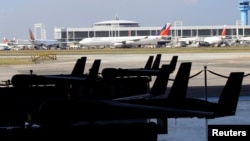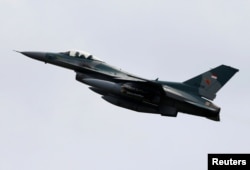Officials in Beijing will treat $47.9 billion in U.S. drone sales approved for Southeast Asia as another effort to dent their claims to the disputed South China Sea, experts believe, and lash back verbally as well as economically.
The U.S. Department of Defense said May 31 American contractor Insitu would sell 34 ScanEagle unmanned air vehicles to Indonesia, Malaysia, the Philippines and Vietnam. All four have chafed against China’s coast guard and other vessels over the past decade as they vie for control over the resource-rich sea.
The United States has no claim to the sea, a 3.5-million-square-kilometer waterway between Hong Kong and the island of Borneo, but Washington wants to keep it open for international use. China claims about 90 percent of the sea, where it has developed small islets for military use. The Southeast Asian states lag China in military might.
Already wary of U.S. navy forays into the sea and Washington’s earlier pledges to upgrade military ties around Asia, Beijing will probably respond to the drones with official anti-U.S. statements and increases in economic aid to the drone buyers, which might otherwise shift foreign policy toward Washington, political scientists say.
“I think that Beijing will see (drone sales) as the United States interfering in what China understands is its core interest, the South China Sea, and Beijing will use this as an opportunity to strengthen the domestic narrative that the United States is attempting to challenge China on many of its core interests,” said Stephen Nagy, senior associate politics and international studies professor at International Christian University in Tokyo.
Drones for Chinese rivals
The American contractor has approval to sell 12 drones to Malaysia, eight to Indonesia, another eight to the Philippines and six to Vietnam, the defense department website says. Deliveries due by 2022 would include spare payloads, spare parts, support equipment and training for the hardware that check Chinese maritime activity from the air, the website says.
Indonesia doesn’t have a claim to the sea, but it periodically challenges Chinese vessels near its outlying Natuna island chain.
The other three drone recipients claim waters that overlap what China calls its own. China cites historical use of those waters; the other countries use exclusive economic zone boundaries defined under international law. Vietnam and the Philippines have sparred with Chinese vessels in the past. Malaysian Prime Minister Mahathir Mohamad is taking a tougher stance against China than his predecessor did.
U.S. officials have twinned more than a year of trade-tariff pressure on China with multiple naval vessel passages through the sea. At the Shangri-la Dialogue defense chiefs’ forum in Singapore June 1, Acting U.S. Defense Secretary Patrick Shanahan pledged more military cooperation in Asia – and criticized China’s expansion.
The drone sales belong to a “bigger narrative” from China’s view, said Eduardo Araral, associate professor at the National University of Singapore’s public policy school.
Chinese response
China may protest briefly against the drone sales and will probably stir domestic opinion in its favor, analysts expect.
“I think what you would see is that the spokesperson of the Ministry of Foreign Affairs (is) reacting, but that’s probably not so much,” Araral said. “The Chinese would say ‘what else is for the drones to discover that the satellites couldn’t discover and that the people on the ground don’t know?’”
The drones, being just for surveillance, are not expected to spark a militarily response or make China scale back the past decade of maritime expansion. China uses its own drones and radar systems in the sea that’s prized for fisheries, oil, gas and commercial shipping lanes.
“Of course they don’t like it, but is this really going to change the tide in the South China Sea?” said Yun Sun, East Asia Program senior associate with the Stimson Center think tank in Washington, D.C.
“Probably not, especially if we take into consideration the relation that China currently has with these Southeast Asian countries -- everything seems to be under control, at least from the Chinese perspective,” she said.
More aid to Southeast Asia
Beijing may seek to increase that control by strengthening its own appeal among Southeast Asian countries – possibly forcing them to choose between China and the United States – some analysts say.
The appeal would be economic. China, backed by the world’s second largest GDP, has helped build infrastructure in Malaysia and the Philippines to date while helping Vietnam by expanding tourism. Some of the aid fits into China’s $1 trillion pan-Eurasia Belt-and-Road Initiative to open trade routes through new infrastructure.
The United States lacks China’s level of economic relations in Southeast Asia.
The Communist leadership might also try to “fracture” a 10-member negotiating bloc, the Association of Southeast Asian Nations, that includes the four drone buyers, Nagy said.








